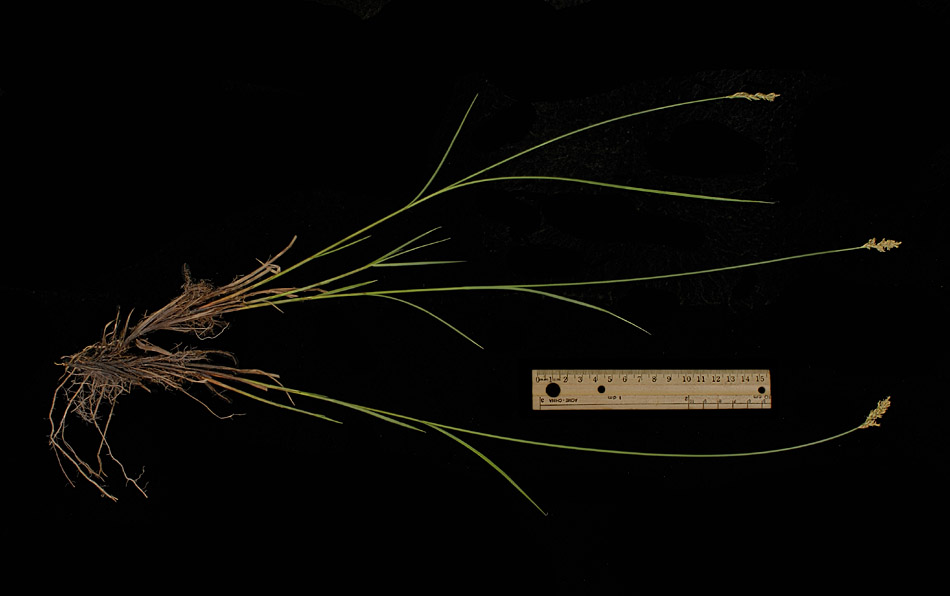 | Diandra:
Answers to key questions in Sedges (Carex) of Saskatchewan, Fascicle 3,
Flora of Saskatchewan by Anna Leighton leading to this species. The
answers are in the order you would normally work through the key.
 |
Stigmas 2;
achenes lenticular. NOT [Stigmas 3; achenes three-sided, occasionally
terete, though their shape may be concealed by flattened perigynia] |
 |
Spikes 2
or more per culm, terminal and lateral; spike bracts present on lateral
spikes; lowest spike bracts usually evident, often conspicuous, even in
compact heads composed of densely bunched and indistinguishable spikes
(except in C. maritima, C. chordorrhiza and C. microptera). NOT
[Spikes 1 per culm, terminal; spike bracts absent] |
 |
Individual
spikes distinguishable in an open inflorescence, or indistinguishable in
a compact head; spikes in any one inflorescence alike in appearance due
to their similar composition (i.e. all are gynecandrous, androgynous,
pistillate or staminate), sessile. NOT [Individual spikes
distinguishable in an open inflorescence (densely bunched in C.
bicolor); spikes in any one inflorescence either markedly different in
appearance (with terminal spike staminate and lateral spikes
pistillate), or subtly different in appearance (with terminal spike
gynecandrous and lateral spikes pistillate), sessile or stalked.] |
 |
Culms
loosely to densely cespitose (occasionally mat-forming rather than in
discrete clumps); rhizomes, if present, usually short with culms arising
close together along them. NOT [Culms single, or a few together,
well-spaced along conspicuous rhizomes or stolons.] |
 |
Spikes
androgynous, (lateral spikes occasionally pistillate in C. prairea); if
heads have indistinguishable spikes, the heads are usually oblong to
elongate in shape. NOT [Spikes gynecandrous, (terminal spikes may
be staminate in SK material of C. mackenziei; pistillate or staminate
spikes occur in Sect. Stellulatae, a group distinguished by spongy
tissue filling lower one-third to one-half of the perigynium); if heads
have indistinguishable spikes, the heads are usually +/- as wide as they
are long and usually widest in middle or toward base.] |
 |
Spikes
usually more numerous, mostly overlapping, and in some species
indistinguishable in a simple or compound inflorescence; beak 0.3 mm
long or longer. NOT [Spikes 2-5, widely spaced along 1.5-3 cm of
culm with only upper few clustered at tip; beak a tiny tube less than
0.25 mm long.] |
 |
Inflorescence
usually larger, if less than 2 cm long then leaves 2 mm wide or wider;
culms in most species over 3 dm high. NOT [Inflorescence small,
0.7-1.5 (2) cm long and to 0.7 cm wide, compact with indistinguishable
spikes; leaves 0.5-1 mm wide; culms (0.4) 0.6-2.6 (4) dm high.] |
 |
Perigynia
body not translucent; lateral margins of perigynia not conspicuously
green-margined except along beak in some species. NOT [Perigynia
body +/- translucent with brown achene showing through walls; lateral
margins of perigynia green and conspicuous.] |
 |
Distal
portion of culm 0.5-1 mm wide (to 2 mm wide in C. vulpinoidea), firmly
three-angled, not easily flattened; culm angles not winged. NOT
[Distal portion of culm 1.5-4 (7) mm wide, soft, easily flattened under
pressure; culm angles with wide, flat wings.] |
 |
Leaves 3
or 4 mm wide at most; dorsal (abaxial) surface of lower leaf sheaths not
conspicuously green and white striped, if septate-nodulose then
partitions between veins faint; plants more widely distributed.
NOT [Leaves 3-5 (8 fna) mm wide; dorsal (abaxial) surface of lower leaf
sheaths conspicuously striped with longitudinal green veins against a
white background and septate-nodulose with prominent partitions between
veins; plants of moist, shady sites in southeastern SK.] |
 |
Only lower
bracts clearly visible, these to a maximum length of 1.5 cm; leaves
shorter than or equal to culms; pistillate scales acute, acuminate or
occasionally mucronate, not awned; ventral strip neither rugose nor
thickened at summit. Section Heleoglochin (C. prairea, C.
diandra). NOT [Bristle-like bracts visible throughout
inflorescence, lower bracts 0.5-6 (13) cm long, often as long as or
longer than inflorescence; leaves longer than culms; pistillate scales
with awns 1-5 mm long; ventral strip rugose with thickened edge at
summit.] |
 |
Summit of
ventral strip whitish with red dots not forming a continuous visible
band; perigynia pale to dark chestnut brown at maturity, almost black
with age, somewhat longer than scales which may be short and translucent
revealing brown potbellied perigynium bodies; inflorescence dark brown
at maturity; spikes and panicle branches closely and regularly
overlapping (lowest occasionally separate) in a cylindrical head.
NOT [Summit of ventral strip a copper-colored band visible with the
naked eye; perigynia straw-colored to brown at maturity, dark brown with
age, often entirely covered by scales that mask their color and shape
except for the long stigmas; inflorescence pale brown at maturity;
spikes and panicle branches loosely and somewhat irregularly overlapping
(lowest often separate, occasionally remote) in an elongate head.] |
|

